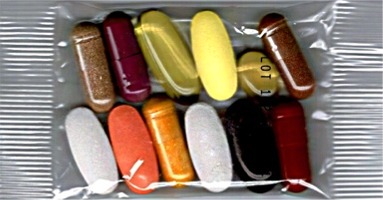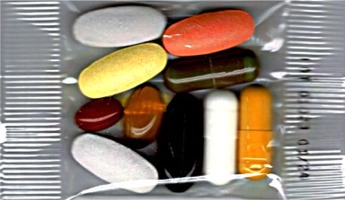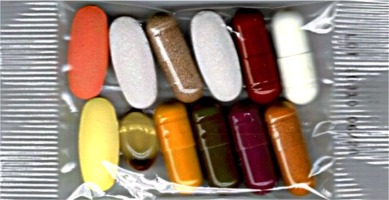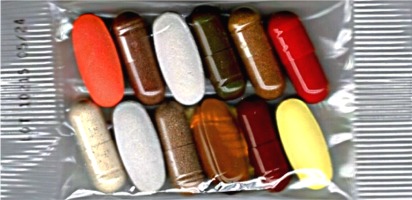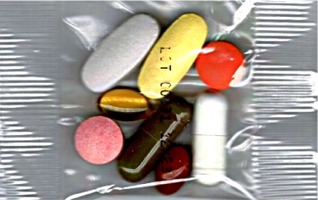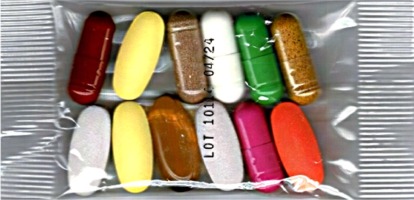Mom always said, "Eat your fruits and vegetables, they'll help you
grow big and strong." Although dietary recommendations have changed over
the years, this is one bit of advice even Father Time can't ignore.
According to recent studies, antioxidant vitamins in produce and other
foods may actually represent a modern-day "Fountain of Youth."
Evidence suggests that vitamins C and E, and beta carotene, a precursor to
vitamin A, may reduce the risk of some forms of cancer, heart disease,
strokes, cataracts, as well as slow the aging process.
How do these compounds work and how far are scientists willing to go in
touting their health benefits?
ANR Formula One,
Two, Three, Four,
Five, Six, Seven
Heart, Alert, Maximus,
CATALOG
Antioxidants at Work
Although oxygen is vital to life, scientists are also finding this
essential element may contribute to human aging and illness.
When oxygen is metabolized or burned by the body, cells form byproducts
called free radicals. Free radicals travel through the cell, disrupting the
structure of other molecules and resulting in cellular damage. Such damage is
believed to contribute to aging and various health problems.
Antioxidants protect key cell components from damage by neutralizing the
free radicals. Antioxidants that occur naturally in the body or are consumed
through the diet may block most of the damage; however, over time, damaged
cells can accumulate and lead to age-related diseases, researchers say.
"Antioxidant defense systems limit [free-radical] formation and
scavenge them, but antioxidant defenses are not 100 percent efficient,"
said Barry Halliwell, D.Sc., of the University of London and the University of
California at Davis, speaking at a symposium sponsored by the International
Life Sciences Institute (ILSI). Over time, "Oxidative stress can damage
proteins, lipids, DNA and carbohydrates."
In an effort to beef up bodily defenses to combat free-radical activity,
scientists are studying the effects of increasing individuals' antioxidant
levels through the diet and dietary supplements.
ANR Formula One,
Two, Three, Four,
Five, Six, Seven
Heart, Alert, Maximus,
CATALOG
Recent Research
Among the most widely-publicized research trials on antioxidants was a
five-year study published earlier this year in the Journal of the National
Cancer Institute involving approximately 30,000 residents of north-central
China. Participants were given either a placebo or a dietary supplement
containing one of seven vitamin-mineral combinations. Persons who received a
daily dose of beta carotene, vitamin E and selenium had a reduced cancer rate
of 13 percent.
Although many questions remain as to the significance of these findings for
other populations, the study represents the first large-scale randomized,
prospective, placebo-controlled study showing the benefits of dietary
supplementation with antioxidant vitamins and minerals. Much of the previous
evidence was based on epidemiological studies of populations, which suggested
an association between antioxidants and disease prevention but were not
designed to reveal cause and effect relationships.
In another recent study reported at the American Heart Association (AHA)
Scientific Session in November, women who consumed high amounts of antioxidant
containing foods had a 33 percent lower risk of heart attack and a 71 percent
lower risk of stroke, than women who ate few antioxidant-containing foods.
The study involved 1,795 female nurses, each of whom had a history of heart
attack, chest pain due to coronary disease, or treatment for a blockage in a
coronary artery. Food intake was analyzed according to subjects' estimated
consumption of vitamins C and E, carotene and riboflavin.
Even after controlling for other variables that can contribute to
cardiovascular risk such as age and high blood pressure, the nurses who
consumed the most dietary antioxidants had the greatest disease reduction.
Individual foods most closely associated with the health benefits included
carrots, spinach and other greens.
"These data suggest that people at high risk because of a history of
cardiovascular disease or events may benefit the most from increased
consumption of fruits and vegetables," said principal investigator JoAnn
Manson, M.D., of Brigham and Women's Hospital in Boston.
"These women were at especially high risk, and any intervention that
impacts on that risk could potentially save a large number of lives,"
Manson added. Health care costs related to cardiovascular disease are expected
to exceed $117.4 billion in 1993 alone, according to AHA.
ANR Formula One,
Two, Three, Four,
Five, Six, Seven
Heart, Alert, Maximus,
CATALOG
Wait and See
Despite these and other promising findings from antioxidant research
studies, many experts are not yet convinced there are adequate data to allow a
health claim on foods or dietary supplements. Questions still remain on issues
such as the effectiveness of individual antioxidant vitamins to prevent which
conditions, their mechanisms of action, optimum levels of intake and their
long-term effects.
Even more contentious is the issue currently being debated by Congress and
the Food and Drug Administration (FDA) over whether dietary supplements
containing antioxidants and other compounds should be regulated as foods or
drugs.
Many health groups such as AHA and the American Cancer Society believe it
is premature to recommend dietary supplements containing antioxidants,
indicating that some other as yet unidentified substance in fruits and
vegetables may actually be responsible for reduced disease risk.
"We can't yet say conclusively that antioxidant vitamins, per se, as
opposed to foods that are high in antioxidants, can reduce the risk of stroke
or heart attack," Manson said. "I would support the public health
recommendation for increased fruit and vegetable consumption among people who
at high risk for cardiovascular disease, as well as for the general public.
But, at this point, I couldn't recommend that people buy vitamin
supplements."
"We're in the first wave," said Nancy Ernst, M.S., R.D.,
nutritional coordinator at the National Heart, Lung and Blood Institute who
spoke at the ILSI symposium. "We need to call for more research. We have
a lot of answers but we also have many, many questions... We've not
sufficiently addressed issues such as other nutritive and non-nutritive
compounds in the diet that may contribute to disease prevention."
ANR Formula One,
Two, Three, Four,
Five, Six, Seven
Heart, Alert, Maximus,
CATALOG
Upping the Antioxidant Ante
Until further studies are completed, eating a balanced diet rich in
antioxidant vitamins may be the best way of improving your health. The
following chart outlines foods high in antioxidants. Resolve to include more
of these foods in your daily diet.
VITAMIN FOODS
Vitamin A/ liver, egg yolk, fortified milk, butter, margarine,
Beta Carotene spinach, carrots, squash, broccoli, yams, tomato,
cantaloupe, peaches, fortified grain products
Vitamin C citrus fruit and juices (oranges, grapefruit),
strawberries, kiwi, cantaloupe, green peppers,
raw cabbage, spinach, kale, broccoli
Vitamin E nuts, seeds, whole grains, vegetable and fish-liver
oils, fortified cereals, dried apricots
ANR Formula One,
Two, Three, Four,
Five, Six, Seven
Heart, Alert, Maximus,
CATALOG
Taking Action
Although much of the scientific community is still calling for further
research on antioxidants before changing public health recommendations, some
consumers aren't waiting for more data.
According to Catherine E. Woteki, Ph.D., R.D., of the National Academy of
Sciences, "Data on supplement sources of nutrient antioxidants show that
36 percent of adults report using vitamin/mineral supplements. Food supply
data and limited data on intakes and supplement use indicate that levels of
vitamins E and C and the carotenoids in the diet have increased among
Americans."
Some nutritionists and policymakers are concerned that individuals will
take excessive amounts of supplements, believing that if a little bit is good,
more must be better. High doses of some antioxidants can produce adverse
affects in people; for example, excessive vitamin E can interfere with the
action of warfarin, a blood-thinning medicine often prescribed for patients
with heart disease.
FDA is examining the scientific data to determine whether there is adequate
scientific data to support a health claim on antioxidants and disease
prevention and is expected to make a decision sometime next year.
Reprinted from the International Food Information Council Foundation, 1993
Also see:
Phytochemicals: Nutrients Of
The Future
Antioxidants: An Antidote to
Aging?
Better Eating for Better Aging
Nutrition Is Key To Successful
Aging: Kidd
Latest Concepts in Nutrition
Life Long Weight Management
for Health & Happiness
10 Tips to Healthy Eating
New Perspectives on Diet and
Cancer
Upbeat on Fiber for Longer
Life & Better Health
A Refresher On Water for Long
Life & Health
Reference Guide for Vitamins
Reference Guide for Minerals
Reference Guide for Herbs
Reference Guide for Amino
Acids
Reference Guide for Special
Nutrients
Reference Guide for
Anti-Oxidants
Reference Guide for Nutritional
Greens
Reference Guide for Digestive
Nutrients
Reference Guide for Dietary
Fibers
Suggested Readings and Guide
References
ANR Formula One,
Two, Three, Four,
Five, Six, Seven
Heart, Alert, Maximus,
CATALOG
|
